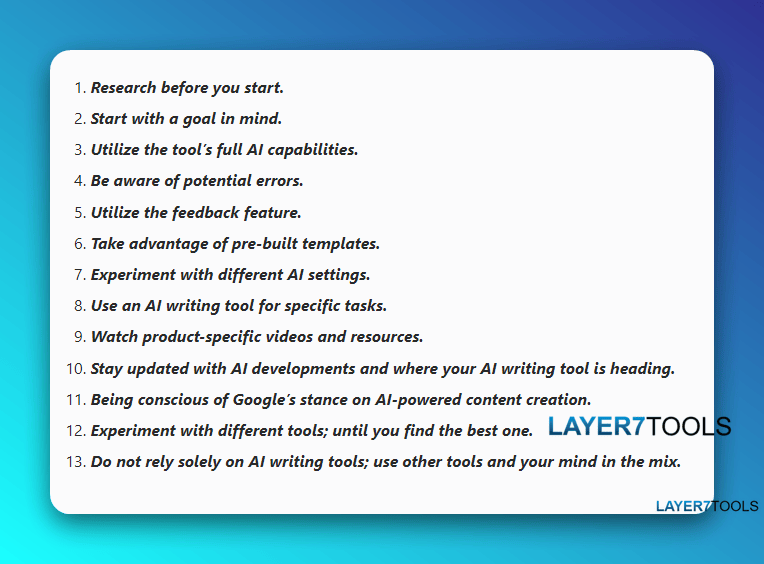13 Important Tips For Getting The Most Out Of Your AI Writing Tool
AI writing tools are a topic of intense interest among bloggers, small business owners, content creators, and marketers, and for a good reason. These tools provide solutions to everyday problems—from grammar correction to writing blog posts to resume writing to make better business decisions.
The importance of AI writing tools is growing day by day. In fact, the results suggest that AI-powered writing tools could be an efficient tool to promote learning behavior and attitudinal technology acceptance through formative feedback and assessment for non-native postgraduate students in English academic writing.
Source:- https://www.semanticscholar.org/paper/Application-of-Artificial-Intelligence-powered-in-Nazari-Shabbir/0456fc51e35b046addc45b3ca314d0ab85b836f6
In this post, I’ll outline 13 ways to make your AI writing tool work for you.
- Research before you start.
- Start with a goal in mind.
- Utilize the tool’s full AI capabilities.
- Be aware of potential errors.
- Utilize the feedback feature.
- Take advantage of pre-built templates.
- Experiment with different AI settings.
- Use an AI writing tool for specific tasks.
- Watch product-specific videos and resources.
- Stay updated with AI developments and where your AI writing tool is heading.
- Being conscious of Google’s stance on AI-powered content creation.
- Experiment with different tools; until you find the best one.
- Do not rely solely on AI writing tools; use other tools and your mind in the mix.

1. Research before you start:
Before you begin using an AI writing tool, it is important to research and understand what the tool is capable of and how it works. Knowing the features and capabilities of the tool will help you get the most out of it.
For example, if you are using an AI writing tool to create a resume, it is important to know what kind of data the tool uses and how it will affect your end product. You should also be aware of any limitations that may exist with the tool so that you can create realistic expectations for yourself.
Read reviews: It’s important to read reviews before using any AI writing tool. These reviews will give you an idea of what people think about the product and whether or not it is worth purchasing. You should also look at the company website and see if they have any customer service policies in place.
2. Start with a goal in mind:
Before you start using an AI writing tool, it is important to think about what you want to achieve with it. For example, do you want to write an article, a blog post, a sales copy, a product description, an ad copy, an email or a letter, or something else? Knowing your goals will help you focus your efforts and get the most out of the tool.
For example, if you want to write sales copy for an ad, you should choose a tool designed to write sales copy. On the other hand, suppose you are looking for a general-purpose AI writing tool. In that case, there are many options already available on the market.
Make sure you take the time to provide the AI tool with the necessary information about your business and goals.
3. Utilize the tool’s full AI capabilities:
AI writing tools come with a variety of AI capabilities, such as grammar and spell-checking, automated formatting, a free-form editor, customized templates, voice recognition, etc., to name a few. Utilizing these capabilities can help you produce a better end product.
For example, grammar and spell-checking can help you avoid embarrassing mistakes, and automated formatting can save you time by automatically creating the layout for you. Voice recognition will allow you to dictate your writing instead of typing it out, which can be especially helpful if you have a disability or injury that makes typing difficult or impossible.
4. Be aware of potential errors:
AI writing tools are still developing, and they can sometimes make mistakes. Therefore, it is important to double-check the output of the AI writing tool to ensure that it is accurate and free of errors.
For example, AI writing tools may make spelling errors or grammatical mistakes. If a tool makes an obvious mistake, you should correct it before using the output as part of your writing.
5. Utilize the feedback feature:
Most AI writing tools have a feedback feature that allows you to provide feedback on how the tool is performing. Utilizing this feature can help you fine-tune the tool and get the most out of it.
For example, if you are using a specific content template within the tool and you don’t like its output, you can give your feedback in terms of “thumbs up” or “thumbs down.” And most of the AI tools out there have this feature built-in.
6. Take advantage of pre-built templates:
AI writing tools always come with a variety of templates that can help you quickly generate content. Taking advantage of these templates can help you get the most out of the tool.
For example, suppose you are using a writing tool that has a template for sales copy like AIDA, BAB, FAB, etc. In that case, it will automatically generate a sales copy for you. You can then use this as a starting point and tweak it to suit your needs.
7. Experiment with different AI settings:
AI writing tools often have a variety of settings that you can adjust to improve the tool’s output. Experimenting with different settings can help you find the one that works best for you.
For example, you can use settings like the temperature to reduce or increase the randomness and the frequency to reduce repetition.
You can also change the number of tokens to make a sentence or paragraph longer or shorter. This can help you increase readability and impact.
Make sure your tool has this feature and that you are using it properly. If you are using a writing tool that does not have this feature, consider switching to one that does.
Tools that have this feature are Contentbot, Riku, and AI-Content Labs.
8. Use an AI writing tool for specific tasks:
AI writing tools are best suited for specific tasks such as writing articles, blog posts or summarizing. Knowing the task the tool is best suited for will help you focus your efforts and get the most out of the tool.
For example, GoCharlie is good at content repurposing. You can paste the Youtube URL, and it will give you a nice, summarized outline to use further to create a blog post or to understand the contents of the video quickly.
9. Watch product-specific videos and resources:
Take advantage of any tutorials or online resources available to better understand how that particular AI writing tool works.
This will also help to set the AI writing tool correctly. Read the documentation. AI writing tools often come with detailed guidebooks and tutorials to help you make the most out of your tool.
10. Stay updated with AI developments and where your AI writing tool is heading:
It’s important to keep up with new developments in artificial intelligence technologies so your AI writing tool can keep running at its best.
It’s important to choose an AI writing tool that’s constantly being updated with new features and improvements.
For example, the recent GPT3 update has shaken the world. Make sure your tool already supports it or is considering it soon.
Do not forget to update your AI writing tool regularly.
11. Being conscious of Google’s stance on AI-powered content creation:
Google recently said that it would use both human reviewers and machine learning algorithms to find spammy, low-quality content and prevent it from showing up in its search results. As an AI writer, you need to ensure that your content is of high quality and suitable for use by Google’s algorithms.
Make sure you bookmark the List of Google Search Ranking Updates page.
12. Experiment with different tools; until you find the best one:
Find the tool that suits your writing style and, most importantly, gives results. For example, if you are in the SEO field, use a tool with built-in search engine optimization (SEO) capabilities. That will ensure that your content is properly optimized for search engine rankings.
13. Do not rely solely on AI writing tools; use other tools and your mind in the mix:
Last but not least, ensure you incorporate manual research and proofread any AI-generated content for accuracy and errors before publishing it.
Use it as a tool instead of a replacement, check the output quality of the content, do research before hitting “go,” and understand that it won’t replace you.
Use SEO tools like Spyfu and Low Fruits for keyword research and tools like Frase and Neuron Writer to write SEO-optimized articles.
Utilize visual feedback and analysis to better understand the kind of content that gains traction in your niche. Then, monitor and measure your content’s performance using free tools like Google Search Console, Google Analytics, etc.
Conclusion
We hope these tips will help you get the most out of your AI writing tool. And if you’re not using an AI writing tool, hopefully, they’ll give you food for thought. Finally, for those of you who are already using these technologies, we’d love to hear how they could be better—please leave us a comment below!
- WPVivid Backup Plugin Review (2023): Backup, Restore, Stage, and Migrate WordPress Sites - March 1, 2023
- How to Write Better Outlines with ChatGPT (Including Prompts) - February 3, 2023
- How to Write good headlines that grab attention and drive conversions - January 27, 2023




